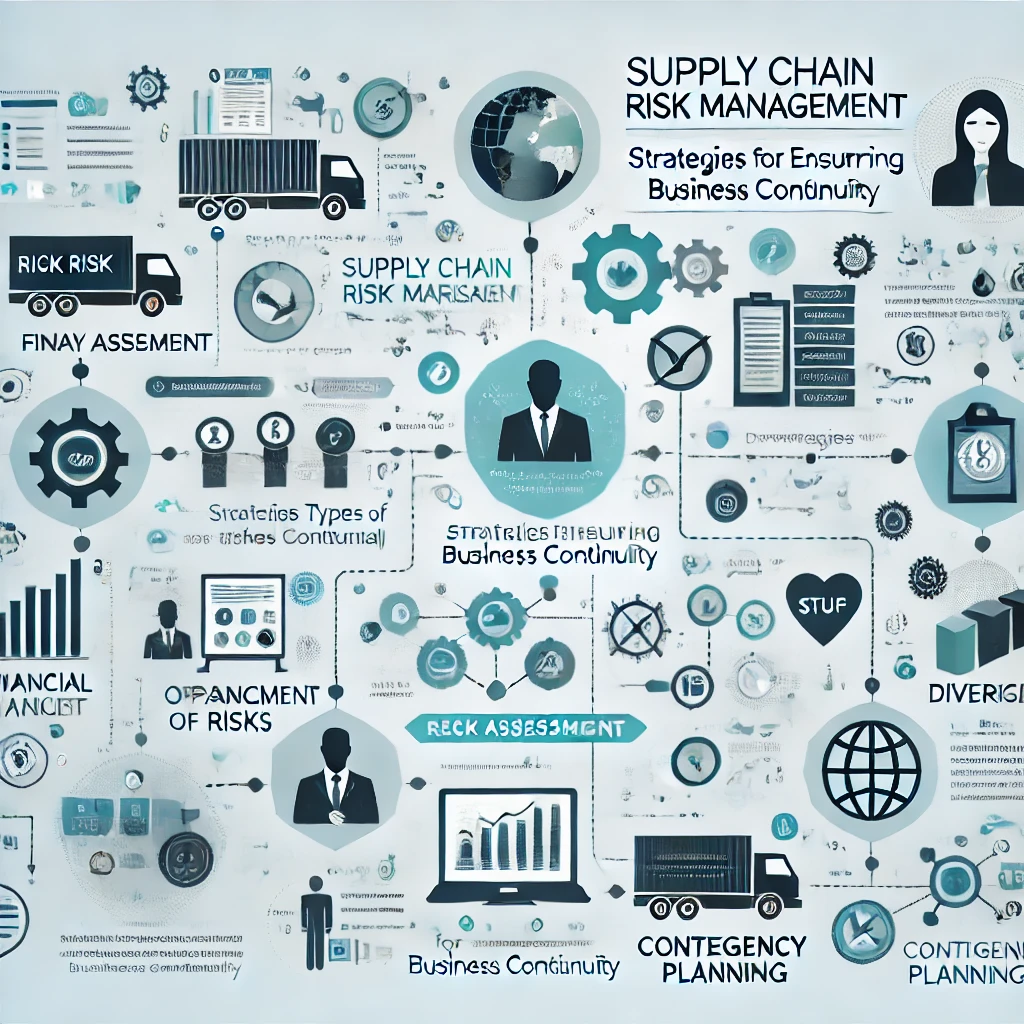Risk Management in Supply Chain: How to Ensure Business Continuity
In today’s interconnected global economy, supply chains are more complex and vulnerable than ever before. Natural disasters, geopolitical tensions, cyber threats, and market fluctuations can disrupt operations and lead to significant financial losses. Effective risk management in supply chain processes is essential to ensure business continuity and resilience. This article explores the key components of risk management in supply chains and offers practical strategies for businesses to mitigate risks.
Understanding Supply Chain Risks
Before delving into risk management strategies, it’s crucial to identify the types of risks that can affect supply chains. These can be broadly categorized into several categories:
- Operational Risks: Disruptions caused by failures in internal processes, systems, or people. This can include equipment failures, labor strikes, or logistical challenges.
- Natural Risks: Events such as earthquakes, floods, hurricanes, or other natural disasters that can disrupt production or transportation.
- Financial Risks: Market fluctuations, currency exchange volatility, and credit risks that can impact the financial stability of suppliers or the cost of materials.
- Geopolitical Risks: Political instability, trade disputes, or regulatory changes in supplier countries that can affect supply chain operations.
- Cyber Risks: Threats posed by cyberattacks or data breaches that can compromise sensitive information or disrupt digital supply chain systems.
- Reputational Risks: Issues that can arise from poor supplier practices, ethical concerns, or failures in product quality that can damage a company’s reputation.
The Importance of Risk Management in Supply Chains
Effective risk management is essential for maintaining the integrity and reliability of supply chains. A well-structured risk management framework can help organizations:
- Identify Vulnerabilities: Recognize potential risks that could disrupt operations and develop strategies to address them.
- Enhance Resilience: Build a more resilient supply chain capable of withstanding disruptions and maintaining operations.
- Protect Financial Performance: Reduce the likelihood of financial losses due to supply chain disruptions and enhance profitability.
- Ensure Compliance: Adhere to regulatory requirements and industry standards, minimizing the risk of legal issues.
- Improve Stakeholder Confidence: Enhance trust among customers, investors, and partners by demonstrating a commitment to risk management and business continuity.
Key Strategies for Effective Risk Management in Supply Chains
To mitigate risks and ensure business continuity, organizations can implement the following strategies:
1. Conduct a Comprehensive Risk Assessment
Regularly assess the supply chain to identify potential risks and vulnerabilities. This involves:
- Mapping the Supply Chain: Create a detailed map of the supply chain, including suppliers, manufacturers, distributors, and logistics partners.
- Analyzing Risk Exposure: Evaluate the risks associated with each component of the supply chain, considering factors like geographical location, financial stability, and operational reliability.
- Prioritizing Risks: Rank risks based on their likelihood and potential impact, allowing organizations to focus resources on the most critical areas.
2. Diversify Suppliers and Sources
Relying on a single supplier or geographic region can increase vulnerability to disruptions. To reduce this risk, consider:
- Multiple Suppliers: Source materials from multiple suppliers to avoid dependency on a single source.
- Geographical Diversification: Establish relationships with suppliers in different regions to mitigate the impact of localized disruptions.
- Local Sourcing: Where possible, consider local suppliers to reduce transportation risks and lead times.
You May Also Like: Cybersecurity Risks: How to Protect Your Business from Online Threats
3. Implement Advanced Technology
Leveraging technology can enhance visibility and control over supply chain operations. Key technologies include:
- Supply Chain Management Software: Utilize integrated software solutions to monitor supply chain performance, track shipments, and manage inventory levels in real-time.
- Data Analytics: Employ data analytics to identify trends, forecast demand, and assess potential risks, enabling proactive decision-making.
- Blockchain Technology: Implement blockchain for secure, transparent transactions and traceability throughout the supply chain, reducing the risk of fraud and errors.
4. Develop Contingency Plans
Creating contingency plans ensures that organizations can respond effectively to disruptions. Key components include:
- Crisis Management Teams: Establish dedicated teams responsible for managing crises and implementing contingency plans.
- Scenario Planning: Develop various “what-if” scenarios to prepare for different types of disruptions, including natural disasters, supplier failures, and cyberattacks.
- Business Continuity Plans: Formulate comprehensive business continuity plans outlining steps to take during disruptions, including alternative sourcing, communication strategies, and recovery processes.
5. Enhance Collaboration and Communication
Effective communication among supply chain partners is vital for risk management. Strategies to enhance collaboration include:
- Regular Meetings: Schedule regular meetings with suppliers and partners to discuss risks, share insights, and coordinate responses.
- Information Sharing: Foster a culture of transparency by sharing relevant information, including risk assessments, performance metrics, and potential disruptions.
- Joint Risk Management Initiatives: Collaborate with suppliers to develop joint risk management strategies, such as shared contingency plans and joint training exercises.
6. Monitor and Review
Continuous monitoring and review of the supply chain are crucial for identifying emerging risks and assessing the effectiveness of risk management strategies. This can include:
- Performance Metrics: Establish key performance indicators (KPIs) to measure supply chain performance and risk management effectiveness.
- Regular Audits: Conduct regular audits of suppliers and processes to ensure compliance with risk management policies.
- Feedback Mechanisms: Implement feedback mechanisms to gather insights from stakeholders and improve risk management practices.
Conclusion
Effective risk management in supply chains is essential for ensuring business continuity in an increasingly complex and volatile environment. By conducting comprehensive risk assessments, diversifying suppliers, leveraging technology, developing contingency plans, enhancing collaboration, and continuously monitoring supply chain performance, organizations can build resilient supply chains capable of withstanding disruptions. As businesses navigate the challenges of the modern supply chain landscape, proactive risk management will be a critical component of their long-term success and sustainability.
Recommended: Top Reasons Why Everyone Needs Insurance
